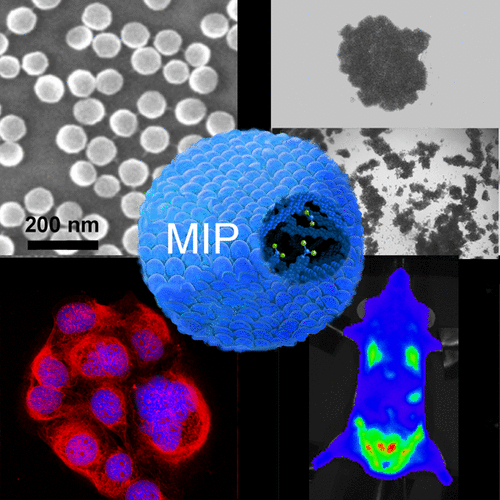当前位置:
X-MOL 学术
›
Chem. Rev.
›
论文详情
Our official English website, www.x-mol.net, welcomes your feedback! (Note: you will need to create a separate account there.)
Molecularly Imprinted Polymers: Antibody Mimics for Bioimaging and Therapy.
Chemical Reviews ( IF 62.1 ) Pub Date : 2020-07-31 , DOI: 10.1021/acs.chemrev.0c00428 Karsten Haupt 1 , Paulina X Medina Rangel 1 , Bernadette Tse Sum Bui 1
Chemical Reviews ( IF 62.1 ) Pub Date : 2020-07-31 , DOI: 10.1021/acs.chemrev.0c00428 Karsten Haupt 1 , Paulina X Medina Rangel 1 , Bernadette Tse Sum Bui 1
Affiliation

|
Molecularly imprinted polymers (MIPs) are tailor-made chemical receptors that recognize and bind target molecules with a high affinity and selectivity. MIPs came into the spotlight in 1993 when they were dubbed “antibody mimics,” and ever since, they have been widely studied for the extraction or trapping of chemical pollutants, in immunoassays, and for the design of sensors. Owing to novel synthesis strategies resulting in more biocompatible MIPs in the form of soluble nanogels, these synthetic antibodies have found favor in the biomedical domain since 2010, when for the first time, they were shown to capture and eliminate a toxin in live mice. This review, covering the years 2015–2020, will first describe the rationale behind these antibody mimics, and the different synthesis methods that have been employed for the preparation of MIPs destined for in vitro and in vivo targeting and bioimaging of cancer biomarkers, an emerging and fast-growing area of MIP applications. MIPs have been synthesized for targeting and visualizing glycans and protein-based cell receptors overexpressed in certain diseases, which are well-known biomarkers for example for tumors. When loaded with drugs, the MIPs could locally kill the tumor cells, making them efficient therapeutic agents. We will end the review by reporting how MIPs themselves can act as therapeutics by inhibiting cancer growth. These works mark a new opening in the use of MIPs for antibody therapy and even immunotherapy, as materials of the future in nanomedicine.
中文翻译:

分子印迹聚合物:用于生物成像和治疗的抗体模拟物。
分子印迹聚合物(MIP)是量身定制的化学受体,可以高亲和力和选择性识别并结合靶分子。MIP在1993年被人们称为“抗体模拟物”,引起人们的关注,从那时起,它们被广泛研究用于化学污染物的提取或捕集,免疫分析以及传感器的设计。由于新颖的合成策略导致可溶性纳米凝胶形式的生物相容性更强的MIP,自2010年以来,这些合成抗体首次在生物医学领域得到青睐,当时首次证明它们可以捕获和消除活小鼠体内的毒素。这项涵盖2015-2020年的评论将首先描述这些抗体模拟物的基本原理,以及已用于制备MIP的不同合成方法,这些MIP用于癌症生物标志物的体外和体内靶向以及生物成像,这是MIP应用的一个新兴且快速增长的领域。已经合成了MIP,用于靶向和可视化在某些疾病中过度表达的聚糖和基于蛋白质的细胞受体,这些疾病是众所周知的例如肿瘤的生物标志物。当装载有药物时,MIP可以局部杀死肿瘤细胞,使其成为有效的治疗剂。我们将通过报告MIP本身如何通过抑制癌症生长来充当治疗剂来结束本次审查。这些工作标志着MIP作为纳米医学未来的材料,将其用于抗体治疗甚至免疫治疗的新开端。MIP应用程序的一个新兴且快速增长的领域。已经合成了MIP,用于靶向和可视化在某些疾病中过度表达的聚糖和基于蛋白质的细胞受体,这些疾病是众所周知的例如肿瘤的生物标志物。当装载有药物时,MIP可以局部杀死肿瘤细胞,使其成为有效的治疗剂。我们将通过报告MIP本身如何通过抑制癌症生长来充当治疗剂来结束本次审查。这些工作标志着MIP作为纳米医学未来的材料,将其用于抗体治疗甚至免疫治疗的新开端。MIP应用程序的一个新兴且快速增长的领域。已经合成了MIP,用于靶向和可视化在某些疾病中过度表达的聚糖和基于蛋白质的细胞受体,这些疾病是众所周知的例如肿瘤的生物标志物。当装载有药物时,MIP可以局部杀死肿瘤细胞,使其成为有效的治疗剂。我们将通过报告MIP本身如何通过抑制癌症生长来充当治疗剂来结束本次审查。这些工作标志着MIP作为纳米医学未来的材料,将其用于抗体治疗甚至免疫治疗的新开端。MIP可以局部杀死肿瘤细胞,使其成为有效的治疗剂。我们将通过报告MIP本身如何通过抑制癌症生长来充当治疗剂来结束本次审查。这些工作标志着MIP作为纳米医学未来的材料,将其用于抗体治疗甚至免疫治疗的新开端。MIP可以局部杀死肿瘤细胞,使其成为有效的治疗剂。我们将通过报告MIP本身如何通过抑制癌症生长来充当治疗剂来结束本次审查。这些工作标志着MIP作为纳米医学未来的材料,将其用于抗体治疗甚至免疫治疗的新开端。
更新日期:2020-09-10
中文翻译:

分子印迹聚合物:用于生物成像和治疗的抗体模拟物。
分子印迹聚合物(MIP)是量身定制的化学受体,可以高亲和力和选择性识别并结合靶分子。MIP在1993年被人们称为“抗体模拟物”,引起人们的关注,从那时起,它们被广泛研究用于化学污染物的提取或捕集,免疫分析以及传感器的设计。由于新颖的合成策略导致可溶性纳米凝胶形式的生物相容性更强的MIP,自2010年以来,这些合成抗体首次在生物医学领域得到青睐,当时首次证明它们可以捕获和消除活小鼠体内的毒素。这项涵盖2015-2020年的评论将首先描述这些抗体模拟物的基本原理,以及已用于制备MIP的不同合成方法,这些MIP用于癌症生物标志物的体外和体内靶向以及生物成像,这是MIP应用的一个新兴且快速增长的领域。已经合成了MIP,用于靶向和可视化在某些疾病中过度表达的聚糖和基于蛋白质的细胞受体,这些疾病是众所周知的例如肿瘤的生物标志物。当装载有药物时,MIP可以局部杀死肿瘤细胞,使其成为有效的治疗剂。我们将通过报告MIP本身如何通过抑制癌症生长来充当治疗剂来结束本次审查。这些工作标志着MIP作为纳米医学未来的材料,将其用于抗体治疗甚至免疫治疗的新开端。MIP应用程序的一个新兴且快速增长的领域。已经合成了MIP,用于靶向和可视化在某些疾病中过度表达的聚糖和基于蛋白质的细胞受体,这些疾病是众所周知的例如肿瘤的生物标志物。当装载有药物时,MIP可以局部杀死肿瘤细胞,使其成为有效的治疗剂。我们将通过报告MIP本身如何通过抑制癌症生长来充当治疗剂来结束本次审查。这些工作标志着MIP作为纳米医学未来的材料,将其用于抗体治疗甚至免疫治疗的新开端。MIP应用程序的一个新兴且快速增长的领域。已经合成了MIP,用于靶向和可视化在某些疾病中过度表达的聚糖和基于蛋白质的细胞受体,这些疾病是众所周知的例如肿瘤的生物标志物。当装载有药物时,MIP可以局部杀死肿瘤细胞,使其成为有效的治疗剂。我们将通过报告MIP本身如何通过抑制癌症生长来充当治疗剂来结束本次审查。这些工作标志着MIP作为纳米医学未来的材料,将其用于抗体治疗甚至免疫治疗的新开端。MIP可以局部杀死肿瘤细胞,使其成为有效的治疗剂。我们将通过报告MIP本身如何通过抑制癌症生长来充当治疗剂来结束本次审查。这些工作标志着MIP作为纳米医学未来的材料,将其用于抗体治疗甚至免疫治疗的新开端。MIP可以局部杀死肿瘤细胞,使其成为有效的治疗剂。我们将通过报告MIP本身如何通过抑制癌症生长来充当治疗剂来结束本次审查。这些工作标志着MIP作为纳米医学未来的材料,将其用于抗体治疗甚至免疫治疗的新开端。


























 京公网安备 11010802027423号
京公网安备 11010802027423号